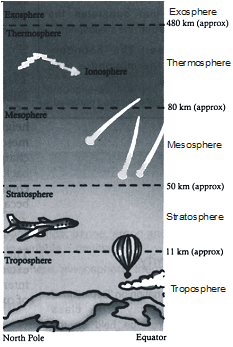- Books Name
- CBSE Class 6 Science Book
- Publication
- Param Publication
- Course
- CBSE Class 6
- Subject
- Science
ATMOSPHERE
The transparent , thick and invisible envelope of air surrounding us is called atmosphere.
It consist of a uniform mixture of permanent gases called dry air and varying amounts of other materials including organic and inorganic impurities such as smoke, pollen grains and dust particles.
The atmosphere is divided in various layers to facilitate the study of it.
The different layers of atmosphere (starting from the surface of earth) are troposphere, stratosphere, mesosphere, thermosphere and exosphere.

Figure : The structure of atmosphere
Troposphere : This is the lowest layer of the atmosphere. It extends to a height of about 11 km above the earth’s surface. All weather phenomena, such as clouds, fog, rainfall, snowfall, storms and lightning occur here. In this layer the temperature of air decreases with increase in height at the rate of 1° C for every 165m. As the troposphere is the lowest and the densest layer of the atmosphere, it absorbs maximum heat radiated by the earth's surface and keeps the earth warm.
Stratosphere : This layer lies above the troposphere and it extends to a height of about 50km above the earth's surface. There are virtually no clouds and very little dust and water vapour convection. The stratosphere contains Ozone which absorbs the harmful ultraviolet radiation of the sun.
Mesosphere : The layer lies above the stratosphere and it extends to a height of about 80km above the earth's surface.
Thermosphere : This layer lies above the mesosphere and it extends up to a height of 480 km. This layer contains electrically charged particles called 'Ions' so it is also called Ionosphere. These particles reflect radio waves back to the earth's surface and unable us to have wireless communication.
Exosphere : The uppermost layer of the atmosphere is called exosphere. It extends to a height of about 1600km and gradually merges with the interplanetary space.

 PathSet Publications
PathSet Publications
 Param Publication
Param Publication
